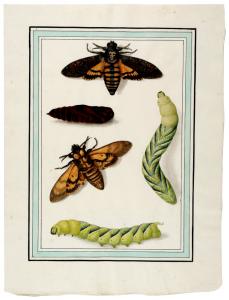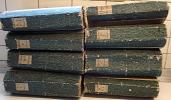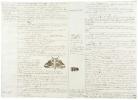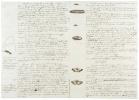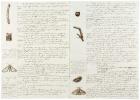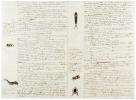Entomological archives, manuscripts and watercolours of the 18th and early 19th century, from the Rémond family, of Semur en Auxois (Burgundy). The authors are Louis Rémond, physician at Semur during the 18th century, F.M. Rémond likewise physician and author of 'Avis aux pères et aux mères sur la vaccine', Dyon & Semur 1818, and his son Maurice Rémond, lawyer at Semur. The greater part of the collection concerns the latter two who both were keen entomologists. The main objects in the collection are 125 watercolour drawings of caterpillars and their cocoons and a full translation into French of Roesel von Rosenhof's 'Der monatlich-herausgegebenen Insecten-Belustigungen'.
Eur 35,000 / USD 40,900
The price shown on each item does not include V.A.T (Value Added Tax). As a result of the recent EU legislation we are required to charge our EU customers the percentage of V.A.T. charged by the customer’s country of residence, unless they possess a V.A.T. registration number. Postage Additional.
The beautifully drawn watercolour drawings of caterpillars are of a superb quality
The main interest of father and son Rémond is the metamorphosis of butterflies. The beautifully drawn watercolour drawings of caterpillars are of a superb quality and the animals are drawn with painstaking precision. The work is very much in the tradition of Maria Sibylla Merian who at the beginning of the same century was fascinated by the same subject and published in 1713-1717 a 3 volumes pioneering work 'Der rupsen begin...' We presume that the watercolours and the extensive notes to these plates are by Louis Rémond and the translation of Roesel von Rosenhof by his son Maurice. The whole project was certainly intended to be published. In a draft (May 1808) of a letter of Maurice Rémond to A.J.P. Kleemann (no. 14), the son of C.F. Kleemann and the son-in-law of Roesel von Rosenhof, Rémond informs him of his intention to publish Roesel's work together with his own observations. "Mes compatriotes les français ne connaissent guère de cet ouvrage que la beauté des figures et ignorent les détails intéressantes que renferme le texte, votre langue étant peu répandu en France; c'est ce qui m'a fait former le projet d'en donner une traduction que l'accompagnerai de mes propres observations". He continues asking him details of his father's life which he wants to incorporate in his work. In a reply dated 30 May 1808 Kleeman wishes him success with his project "Je souhaite la plus heureuse réussite de votre projet louable', and adds several pages of text concerning the life of his father C.F. Kleemann. The work of De Geer (no. 3) and Reaumur (no. 4) were studied in detail, notes and drawings were made as well as numerous notes of other authors.
The town of Semur was a small centre of scientific studies. Not far from Semur, in Montbard, one of France's most famous naturalists Buffon was born. His main collaborator, Gueneau de Montbéliard lived in Semur. There must have been frequent contacts between the father and son Rémond and these two famous scientists. Between the various documents (no. 14) and papers there is an invitation of the family Guenau inviting Mr. and Mrs. Rémond for a concert (28 Aôut 1797). Among the papers there is a note by Maurice Rémond referring to frequent visits made to M. de Montbéliard. On the same sheet he discusses the 'Encyclopédie Méthodique' published by Panckoucke and later Agasse and tells the following about the daughter of Panckoucke: 'Madame veuve Agasse, née Pankouque, est sans doute la fille de M. Pankouque, venue à Semur dans son enfance et qui a été inoculer par mon père'.
This interesting collection shows the keen interest in natural history, especially entomology in the French countryside during the second half of the 18th and beginning of the 19th century. This highly interesting period was characterized by rapid changes due to the French revolution.
The collection comprises about 50 volumes and is composed as follows:
1) Collection de Chenilles et de quelques Papillons que j'ai peints d'après Nature. 125 drawings (305 x 230mm) in watercolour showing caterpillars and cocoons, all within an ink drawn frame. Most of the plates show a caterpillar and its cocoon, sometimes there are more to a plate. Occasionally there is only one cocoon or caterpillar to a plate. Each plate is preserved in a folded sheet, dated 'l'an troisième de la République' (1795) with the plate number and the name of the insect in French in manuscript. The collection has a manuscript title as quoted above, and 10 manuscript leaves of index. Preserved in a contemporary blue cardboard box.
The collection is classified as follows: Chenilles épineuses, Papillons de jours; Chenilles rases ou demi-velues, Chenilles-cloportes & Papillons de jours; Chenilles à corne sur le dernier anneau. Sphinx; Chenilles rases; Chenilles à tubercules velus; Chenilles velues; Arpenteuses à 10 jambes; Chenilles à 12 et à 14 jambes. Each section is in a paper wrapper with the classification in manuscript.
ADDED: 4 contemporary cardboard boxes with explanatory text relating to the above collection of watercolours with the following lettering:
P.D.J. [Papillions de Jours] & SPH. [Sphinges]
CH.R. [Chenilles rases]
CH.V. [Chenilles velues]
ARP. [Arpanteuses]
The 4 boxes contain the full descriptions of 123 of the 125 watercolours and have corresponding numbering. Each description covers mostly several pages, and gives in neat handwriting the name of the insect together with its finding place as well as the date. The caterpillar and its life cycle are meticulously described. It describes the metamorphosis of the caterpillar into a cocoon, and the cocoon into a butterfly. These observations cover sometimes several months. Extensive reference is made to the works of de Geer, Reaumur, Merian, Roesel, Swammerdam and others, in many instances supplemented by elaborate pen drawings.
2) Traduction littérale de Roesel: Divertissement de l'histoire naturelle des insectes donné par mois. A French unpublished translation of Roesel von Rosenhof's 'Der monatlich-herausgegebenen Insecten-Belustigung'. Nürnberg 1746-1793.
This French translation in 6 folio volumes (bound in 7) in neat handwriting is bound in contemporary uniform boards and was made between 1807 and 1810. The set comprises the supplement by C.F. Kleeman and the final supplement by C. Schwarz.
Roesel. Amusemens Périodiques sur les Insectes. 5 volumes (bound in 3). 4to. Contemporary boards. An abridged version in French in manuscript of Roesel von Rosenhof's' 'Der monatlich-herausgegebenen Insecten-Belustigung', probably predating the above final translation. In some cases Rémond's own observations are noted as well (e.g. volume 4 page 91). The first volume has some pages inserted of an earlier draft with a nicely calligraphic title 'Amusemens Périodiques... traduits par M. R(émond). Added are 3 preparatory volumes in manuscript. 1: 'Traduction abrégé des amusemens périodiques, tome premier. Par M. R (émond); 2: Brouillon à garder: Histoire des Polypes d'eau douce...; 3: 'Phalenes ou papillons d'arpenteuses: classes non faites par Ernst. Notes relatives au volume qu'il faudrait faire en réunissant tout ce qu'en ont dit Roesel, Kleemann et Schwarz. Songer à Gladbach'. A manuscript of about 250 pages, translations of above mentioned authors together with his own observations.
3) De Geer, Charles. Mémoires pour servir à l'histoire des insectes. (1752-78). Manuscript extracts and notes of De Geer's work, supplemented by many very attractive drawings in ink. About 240 pages.
4) Notes et observations sur les papillons tirés de Réaumur. Manuscript notes (186 pages), with some drawings in ink on Reaumur's 'Mémoires pour servir à l'histoire des insectes' (1734-42). Together with: Merian. Extrait du recueil des Insectes de Surinam. pp. 25 [and] Papillons, division de Linnée. Citations de beaucoup d'autres auteurs... pp. 24. On page 4 Remond makes reference to his father 'Voir le manuscrit de mon père pour les autres ordres'.
5) [ABEILLES] Essai d'un manuel pratique sur l'éducation des abeilles. Pour être présenté au concours ouvert par la Société d'Agriculture du Département de la Seine. A manuscript of 64 pages on bees. Together with a manuscript extract of 54 pages of Rozier's 'Traité sur les abeilles'.
6) Manuscript notes and extracts on various natural history topics, mostly entomological. Dates are between 1793 and 1833. Preserved in a contemporary cardboard box.
7) Classification. Méthodes de divers auteurs. Manuscript notes on the classification of insects by authors such as Fabricius, Dumeril, Geoffroy, and Schaeffer.
8) Livres à acheter, achats, & notes bibliographiques. A collection of manuscript notes on books, books to be bought and purchased books, as well as bibliographical notes. Such as 'Note des principaux ouvrages sur les insectes qui se trouvent à la bibliothèque de Dyon'; 'Livres à acheter', 'livres achetés à la vente de M. Bertin'. The dates range from 1799 to 1834.
9) Bibliographie Entomologique: Auteurs. A large collection of bibliographical notes on entomological publications. There is a date of 1805 on the cover.
10) Sturm, Jacob. Translation of 'Deutschlands Fauna: Die Amphibien & Die Würmer'. Traduction littérale des Amphibies de Jacob Sturm, 2 vols. & Traduction littérale... les Vers. 1 volume. [with:] Sturm, Jacob. Deutschlands Flora. A first draft of a partial translation of Sturm's large publication of the Flora of Germany. With 'Cent enveloppes gravées pour les planches de la flore Allemande qui paraîtront par la suite', containing the engraved title pages 'Flore d'Allemagne dessinée d'après nature et gravée par Jaques Sturm' for a planned publication. Preserved in a contemporary cardboard box. [and] One portfolio with some notes.
11) Collection académique composée des mémoires, actes et journaux des plus célèbres académies et sociétés littéraires de l'Europe; concernant l'histoire naturelle, la botanique, la chymie, la physique expérimentale, la médecine, l'anatomie, &c. Tome quatorzième et dernier de la partie étrangère, contenant à la fin l'extrait des éphémérides de l'Académie des Curieux de la nature depuis 1688 jusqu'en 1702. Traduit (crossed out) par feu M. Rémond, docteur en médicine et membre correspondant de l'Académie des sciences, arts et belles lettres de Dyon. Folio. 1048 pages in manuscript. [and] Table générale alphabétique des matières continues dans les quatorze volumes de la collection académique, partie étrangères. (Tables A to P). 4to. About 250 pages in manuscript.
12) Scholarly manuscripts mostly of an earlier period: Cursus Philosophicus... Dominus Johannes Nicolaius Guillaume socius Sorbonicus et philosophicus professor, in collegio Sorbonnae Plesseo an. 1721 et 1722. pp. 800. [and] Physiologie de Pyrs. Paris 1751. pp. 453. Manuscript signed by Ludovicus Remond. [and] Medical notes. 11 fascicles of medical notes in neat handwriting, numbered 1 to 11. Each part has about 150 to 200 pages. The last part has a date 1769. Contemporary marbled boards [and] One small portfolio with early notes, some medical, others botanical.
13) Herbal of dried plants of Semur and its surroundings. 9 large and thick volumes in folio. Contemporary boards. The dried plants have handwritten labels with their French and Latin names. On several specimens the location is mentioned such as 'dans mon jardin', 'à Dyon', trouvée à Molime en août', and sometimes a date (such as 1796). The contents of the album is rather fragile, and a number of plants have become loose and some are missing.
14) Mostly personal documents concerning Maurice Rémond, including letters addressed to him concerning books he wants to be bought for him in Paris. One letter dated as late as 11 April 1836 addressed to 'Monsieur Remond ancient juge à Semur'; Notes 'Ordre de travail', a manuscript list of the 100 most important citizens of Semur 'Liste des 100 citoyens les plus imposés résidans dans la ville de Semur', dated 24 May 1809 with the stamp of the city of Semur; a manuscript list of the street names of Semur 'Noms des rues de la ville de Semur en Côte d'Or'; a list of servants (1763-1792); a manuscript revolutionary song 'Faisons l'amour faisons la guerre', with signatures of Remond; Correspondence Maurice Rémond to A.J.P. Kleemann, the son of C.F. Kleeman and the son-in-law of Roesel von Rosenhof (see above); 'à mettre dans l'avertissement', in which Maurice Rémond writes among other things that in order to understand the text of Roesel's work he decided to learn German, and that he was assisted by a German who knew well the French language.

